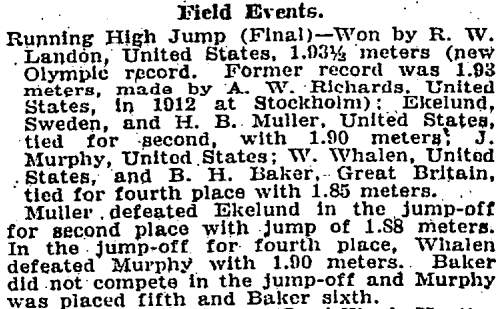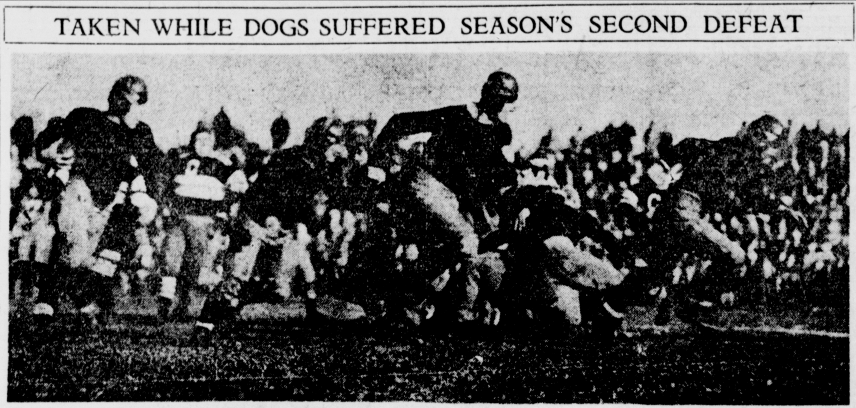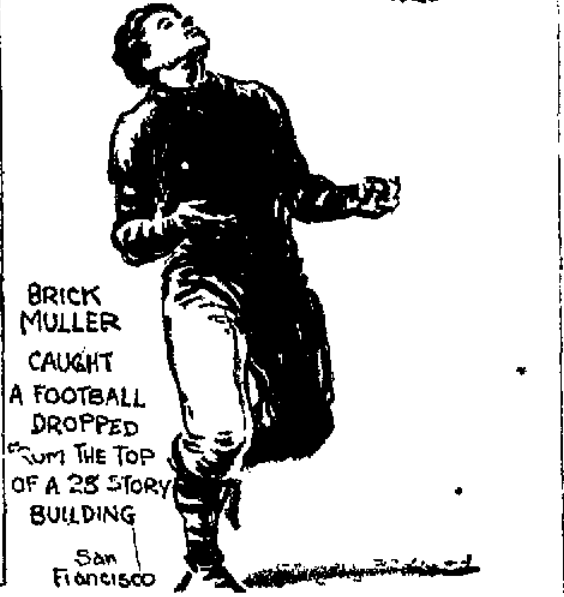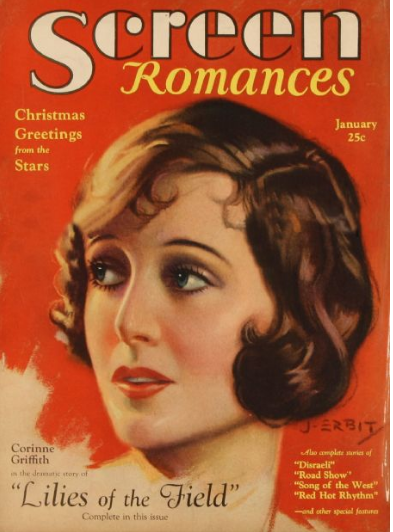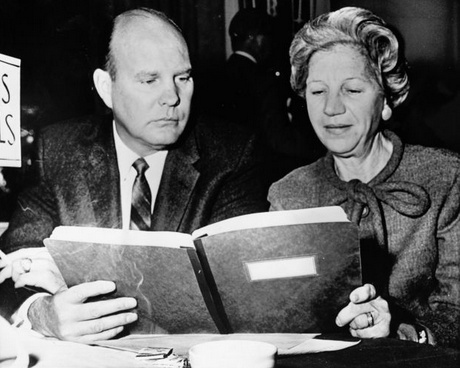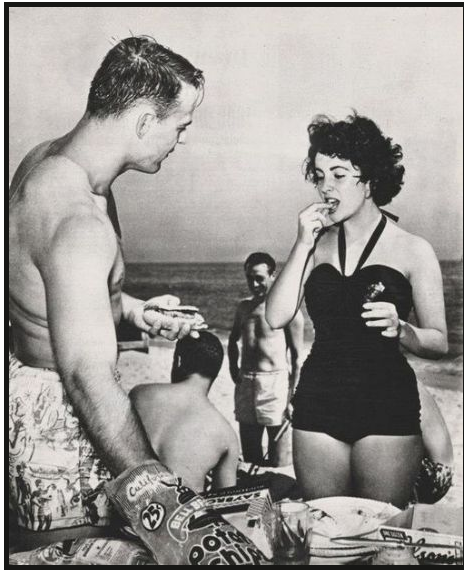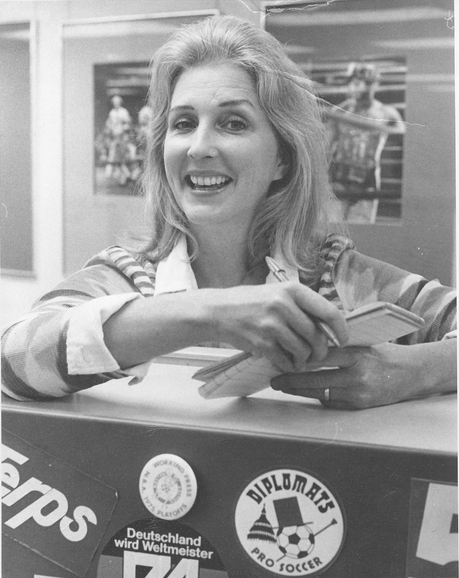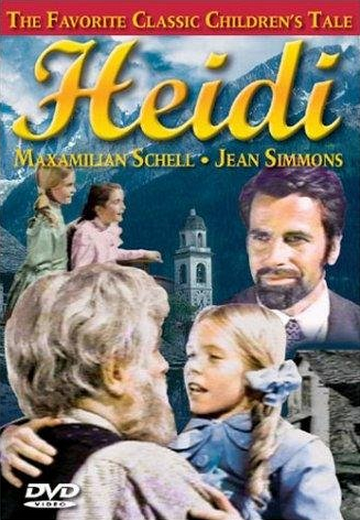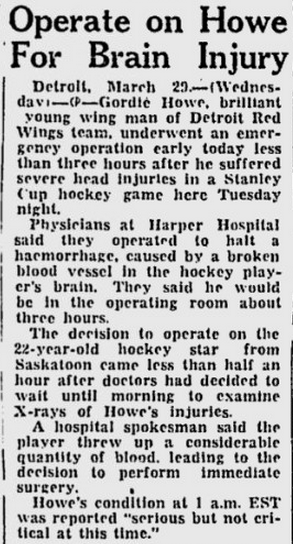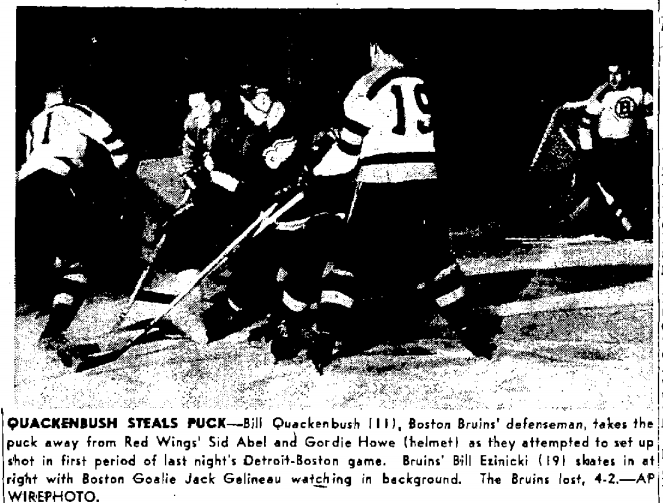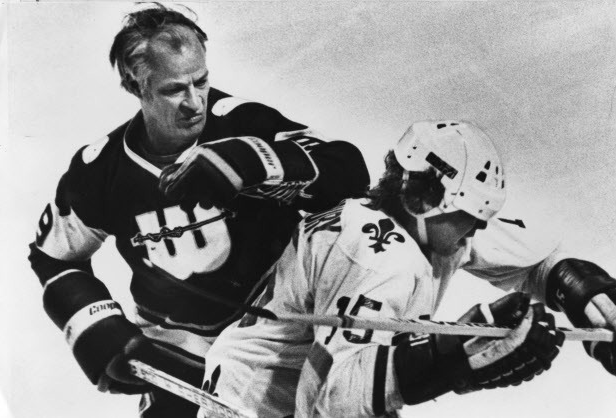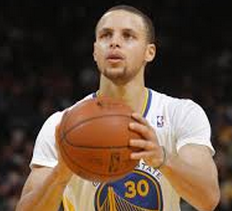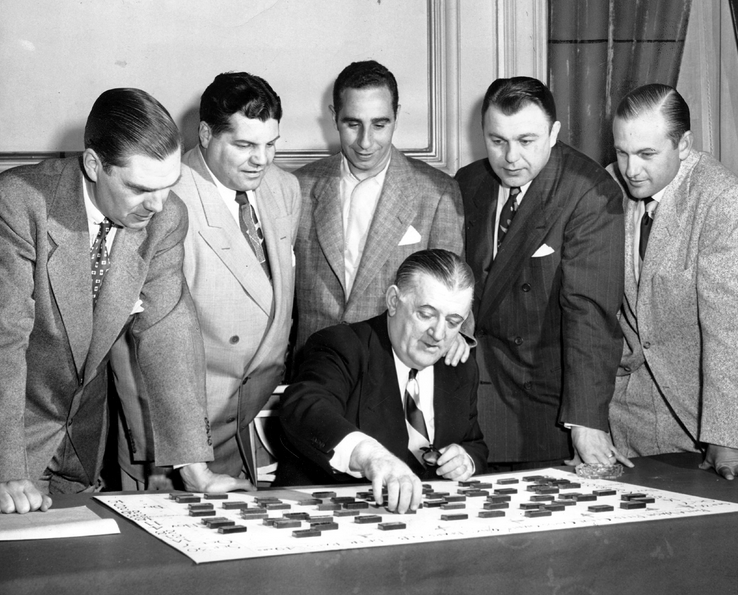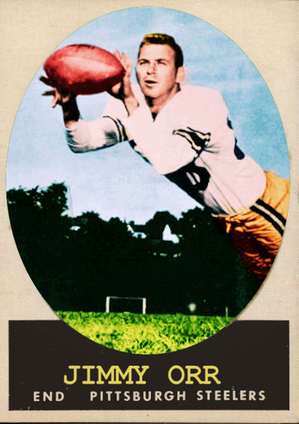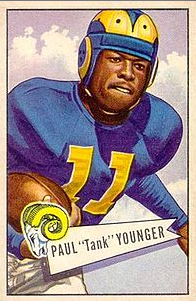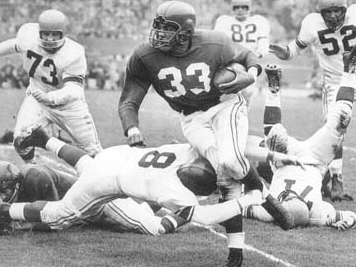A year from now Los Angeles, bereft of an NFL franchise for nearly two decades, might finally have a team again . . . or a couple of them. There are so many scenarios, so many clubs (Rams, Chargers, Raiders) and stadium sites (Inglewood, Carson) in the mix, it’s enough to make you feel concussed.
If the Rams do return to L.A., where they played in four title games and won it all in 1951, there’d be a very Prodigal Son aspect to it. It tends to be forgotten, though, that they weren’t the city’s first NFL team. No, the city’s first NFL team preceded the Rams by 20 years. I’m talking about the 1926 Los Angeles Buccaneers.
Some explanation is in order. After all, putting a franchise on the West Coast in the ’20s was an utterly insane idea. It would have posed travel problems — in terms of both time and expense — for everybody. (This was when the train was king, remember.) So the league made the Buccaneers a “road team.” That is, they carried Los Angeles’ banner, but they never played any games in L.A. They were always the “Visitors” on the scoreboard.
They weren’t the only road team that season, either. The Duluth Eskimos, Kansas City Cowboys, Akron Indians, Dayton Triangles and Columbus Tigers all fell in the same category. Usually a club was designated a Traveling Show because it didn’t draw well at home, but the Buccaneers’ case was different: Los Angeles was just too many time zones away.
Pro football was gaining traction then, though, and plenty of cities wanted in on it. This was the year after Red Grange had joined the Chicago Bears in late November, within days of his final game at Illinois, and drawn record crowds wherever he played. As it turned out, the growth wasn’t sustainable. It was more of a bubble. But no one knew that in 1926. So a second league, the nine-team American Football League, was formed (with Grange as the main attraction), and the NFL branched out to the Pacific Coast.
The Buccaneers, whose colors were orange and black (like the Bengals), weren’t always called by their given name. As often as not, newspapers referred to them as “Brick Muller’s Californians of Los Angeles” — or some variation. Muller, a fabulous two-way end, was the name above the title, a former All-American whose University of California teams (1920-22) never lost a game.
Brick — so dubbed because of his red hair — was famous before he even played a snap for the Cal varsity. After his freshman year, at the age of 19, he won a silver medal in the high jump at the Olympics. (That might explain the following description of him in The Brooklyn Eagle during the ’26 season: “How he does catch ’em! There can be three or four of the opposition awaiting his arrival at a given spot, but more often than not at the mentioned meeting place the pair of arms that grab the ball from the air are Muller’s.”)
There was nothing, it seemed, Muller couldn’t do. The Buccaneers would even use him to throw passes, especially long ones. He had huge hands — a big help in the days of the fat football — and a strong arm. In the Rose Bowl against Ohio State after the 1920 season, he heaved a touchdown pass that was originally said to have traveled 70 yards in the air (though a revisionist sportswriter later put the distance at 53).
Westerners talked about Brick the way folks in the Heartland would talk about Bronko Nagurski — as a force of nature. Here’s a photo of him on an exercise bike during the ’26 season: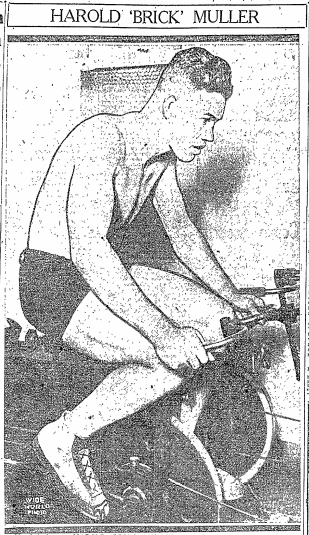
The cutline reads: “Yes, it is the same Harold (Brick) Muller who used to star in football, track and baseball for the University of California. He was recently acclaimed the most perfect physical specimen of manhood in the world by European doctors and athletic directors. Muller is now running the Los Angeles professional football team in the East. The picture shows Muller training on a bike in Rolley’s gym in New York.”
Oops, almost forgot. Brick also co-coached the Buccaneers with tailback Tut Imlay, a former college teammate. Indeed, of the 18 players who suited up for the club at one time or another, seven had played at Cal. The roster had such a Berkeley flavor that the Syracuse Herald referred to the team as the “California Bears.”
Five other players, meanwhile, had gone to schools elsewhere in the state and three more were from the West. It made for a great marketing tool, because there was much curiosity back East about Left Coast Football, due largely to the exploits of Muller’s California “Wonder Teams.” Buccaneers games were billed as East-vs-(Wild) West battles, and the team represented Left Coast Ball well.
After the Buccaneers went into Canton and beat the Bulldogs, featuring Hall of Famers Jim Thorpe and Fats Henry, the Canton Daily News reported: “Football, as played on the Pacific Coast, has not been overrated, judging from the form the Los Angeles Californians displayed Sunday at Lakeside Stadium while scoring a 16-13 victory over the Bulldogs in a National [Football] League engagement. It was the most sensational game seen here in a long time, being filled with thrilling forward passes, return of punts, end runs and good defensive football.”
Imlay, a 5-foot-8, 165-pound dynamo, came in for particular praise for his punt returning. Quick kicks, you see, were popular in that era, and any safety who could hustle back and grab them before they hit the round was a valuable man. One paper noted that he “caught punts over his head, like a ballplayer catches flies.”
“The Los Angeles Californians,” in other words, were hardly a one-man team. Tuffy Maul, from St. Mary’s, was a rugged fullback who also could kick. And lineman Don Thompson, from Redlands, scored two defensive touchdowns (when TDs really meant something). Most of the players, moreover — but not Muller, from what I can tell — played the full 60 minutes. (My guess: Brick carried so much of the load on both sides of the ball — and had such a target on his back, being a superstar and all — that it was hard for him to play the whole game. At some point, he’d need a few minutes to gather himself.)
The adventures of the Buccaneers open a window to The Way It Was in those early years. They lost their opener in Chicago, for instance, 15-0, when the Cardinals returned a fumble for one TD and blocked a punt for another. (Translation: The game was as tilted toward the defense then as it is geared toward the offense today.)
In Buffalo, they slogged to a 0-0 tie against the Rangers in a heavy rain, one that limited the crowd to 3,000. (Before season tickets became the norm, pro football was dependent on the weather to an unhealthy degree. As a result, attendance could fluctuate wildly from week to week.)
In Providence — where they nipped the Steam Roller, 7-6, on a missed PAT — they got to experience the most unique stadium in the league: the Cycledrome, a bicycle track with a football field laid out inside it. (Well, most of a football field. The corners of the end zones were cut off because of the curve of the track, which was sharply banked.)
And in Pottsville, deep in Pennsylvania coal country, they likely fell victim to one of the biggest home-field advantages in NFL history. The fans at Minersville Field were brutally partisan — it was like one big Dawg Pound — and the officiating was sometimes suspect, too.
“I guess our toughest defeat was there,” Thompson told the Los Angeles Times in the ’50s. “There was a quarter of an inch of ice on the puddles in the playing field that had to be broken before the game. The spectators stood on the sidelines and threw chunks of coal at us through the entire contest. We scored four touchdowns that were not allowed.”
Yup, sure sounds like Pottsville (though the Maroons, in their defense, finished third in the league and blanked 11 of their 14 opponents).
After spending six weeks off Broadway, the Buccaneers Across America tour hit New York. How a team played on the big stage, in front of discerning Big Apple sportswriters, always mattered, and Muller and Co. didn’t disappoint. They had back-to-back games there — against the Giants at the Polo Grounds the first Sunday and the Brooklyn Lions at Ebbets Field the next — and posted a pair of shutouts: 6-0 and 20-0.
The way the Giants promoted the game was almost as entertaining as the game itself. Two days before, they dispatched end Lynn Bomar to the top of the American Radiator Building — not far from Times Square — and had halfback Hinkey Haines stand 324 feet below in Bryant Park. The players’ goal, aside from making a spectacle of themselves, was to complete “the longest ‘forward pass’ on record,” The New York Times said.
They were just poking a little fun at Muller, who once, to advertise the East-West Shrine Game, had caught a 320-foot pass thrown from the roof of the Telephone Building in San Francisco (a feat that so impressed Robert Ripley that he paid homage to it in one of his Believe It or Not! newspaper cartoons).
It took several tries for Bomar to connect with his receiver. His first pass “hit the sidewalk and burst,” according to the Times, and another struck Haines with such force that it knocked him down. At this point Hinkey removed his coat, got down to business and, on the fifth attempt, hung onto the ball — bringing applause from several-hundred onlookers.
A few more several hundred showed up for the game — 20,000 did, in fact — so the stunt served its purpose. It was the Buccaneers’ biggest gate of the season by far, and Muller was at his very best. He “was easily worth the price of admission,” the Bridgeport Telegram said. “In practice he tossed half-a-dozen 50-yard forward passes, and in the game he tossed three fairly long ones for good gains. He also caught a forward pass, made a 23-yard end run and generally made things tough for the New York side of the argument. His snub nose was in the thick of the fight all afternoon.”
After laying waste to New York, the Buccaneers headed west for their final two games. On Thanksgiving in Detroit, they edged the Panthers, 9-6, with the aid of a fluke play — so fluky that Muller was still trying to make sense of it decades later. At football dinner in 1960 he bumped into Hall of Famer Jimmy Conzelman, the player-coach of that Detroit club, and it wasn’t long before Brick was reminding him of “the screwiest play I ever saw.”
Jimmy remembered it well. “I never saw one like it before or since,” he said.
Brick: “Here’s what happened. Jimmy’s team had to punt from the end zone in snow, rain and mud. The ball skidded off the side of the kicker’s foot and shot out of bounds before it crossed the goal line. How do you score it? I argued with the referee that it was our ball once it left the kicker’s foot and had to be a touchdown. He ruled it a safety. I guess he was right.”
The Buccaneers wrapped up the season in Kansas City against the (original) Cowboys. I’ll get to the details in a moment, but first check out this ad that ran in the K.C. Journal the week of the game. Note, in particular, the last line — and the soccer game that was to precede the football game. “As a preliminary . . .,” the Journal reported, “the Hutchison Electric Company’s soccer team, a member of the Kansas City soccer league, will play the Chicopee, Kan., soccer team. The soccer game . . . is expected to draw many fans to the park.”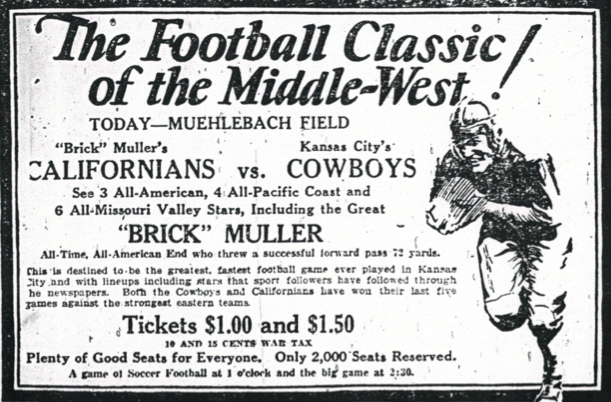
Muehlebach Field, home of Cowboys, was a hopping place on Sunday. “The game,” The Associated Press said, “was given a college atmosphere when two cheerleaders, formerly of the University of Missouri, tainted their amateur standing by leading 3,000 frenzied fans in organized cheering, believed to be an innovation in ‘pro’ football games. The crowd yelled their cheers from printed formulae on the programs, and by the second half gave a good imitation of a college bleacher in action.”
Unfortunately for the Buccaneers, Muller, who was voted all-pro that year, was sidelined in the second quarter by a knee injury, and they went down to a 7-3 defeat. That left them with a 6-3-1 record, good for sixth out of 22 teams (though they didn’t play the league’s two best clubs, the Bears or the Frankford Yellow Jackets).
The season wasn’t quite over, though. After getting back to Los Angeles, the Buccaneers staged some exhibition games to make a few extra bucks, two of them at L.A.’s Wrigley Field against Grange’s New York Yankees, an AFL team. These were their only “home games,” even if they didn’t count in the standings. The Buccaneers took the first (30-6) but dropped rematch (14-0) — a loss made worse when Maul suffered a broken leg.
In the offseason, pro football contracted dramatically. Eleven NFL franchises — the Buccaneers among them — disappeared, and the struggling AFL closed up shop. It was simply too much, too soon. Only three L.A. players ever played in the NFL again, and just one had much of a career (center Jack McArthur, who played five more years for six different teams).
As for Muller, he turned his attention to medicine and eventually became an orthopedic surgeon. But then, pro football in those early decades was a short-lived thing for most guys. The pay wasn’t great, there was little security, and you were wise to get out before you broke something that couldn’t be fixed.
After the war the Rams arrived and gave Los Angeles its first real NFL team, one that actually played games in L.A. But the Buccaneers weren’t totally forgotten. In 1959 the Rams honored them between halves of their opener against the Giants — one of the clubs, you may recall, the Buccaneers beat in their only year in the league.
Reunited for the first time in years, the Buccaneers swapped stories about their season-long travels. Walter Beach, their business manager, told the Times, “We were down to a dozen men at Brooklyn . . . because of injuries. So we picked up some boys off the street and suited them up so our opponents wouldn’t know our plight.
“The team went broke in New York but we managed to scrape enough money together to keep going. From that time on we rode the chair cars on the train [instead of Pullman sleepers].”
Thompson had another memory: “We were almost overcome with fumes from an unvented gas heater in Kansas City, and how we ever played at all that day I don’t know.”
And now, if all the i’s get dotted and all the t’s crossed, Los Angeles might soon be graced by the NFL’s presence again. But the Buccaneers — Brick Muller’s Buccaneers — were there first . . . and did the city proud. All 18 of them.
Source: pro-football-reference.com

